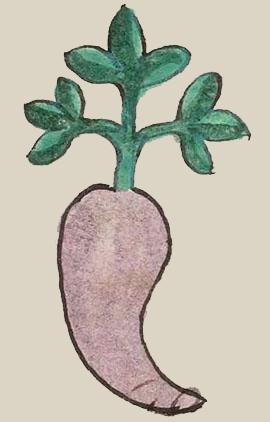camotl (Mdz44r)
This element for what was originally thought to be a cimatl (an edible, medicinal root) has been carved from the compound glyph for the place name, Cimatlan. The predominant part of the place name refers to the medicinal plant. The root is a light purple and the foliage is green. The point of the root curves to the viewer's right.
Stephanie Wood
According to a presentation by Michel Oudijk (Library of Congress, 4/18/2023), the glyph for "cimatl" was misread by the person glossing it. Thus, the gloss refers to the camote, sweet potato, which is camotli in Nahuatl. Knowing the Oaxaca context is essential for catching the error of the gloss, as Oudijk has explained.
Stephanie Wood
c. 1541, but by 1553 at the latest
Stephanie Wood
yam, yams, sweet potatoes, camotes, boniatos

cima(tl), an edible, medicinal root, https://nahuatl.wired-humanities.org/content/cimatl
camo(tli), a sweet potato, https://nahuatl.wired-humanities.org/content/cimatl
an edible root, sweet potato
el camote
Stephanie Wood
Codex Mendoza, folio 44 verso, https://digital.bodleian.ox.ac.uk/objects/2fea788e-2aa2-4f08-b6d9-648c00..., image 98 of 188.
The Bodleian Libraries, University of Oxford, hold the original manuscript, the MS. Arch. Selden. A. 1. This image is published here under the UK Creative Commons, “Attribution-NonCommercial-ShareAlike 3.0 License” (CC-BY-NC-SA 3.0).




